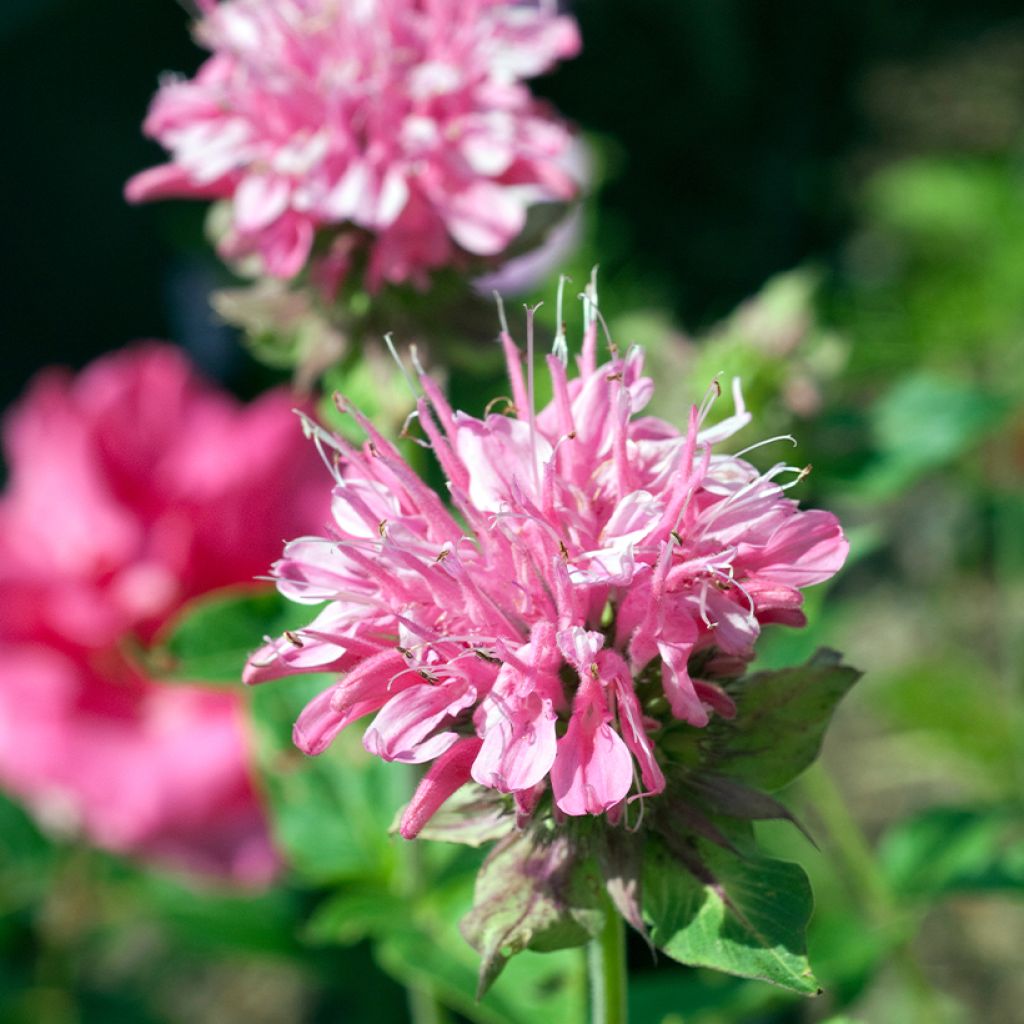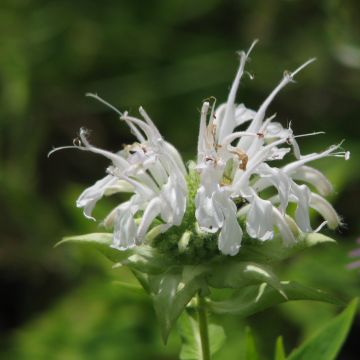

Monarda didyma Sugar Buzz Pink Frosting
Monarda didyma Sugar Buzz Pink Frosting
Monarda didyma Sugar Buzz® Pink Frosting
Bergamot
This item cannot be shipped to the selected country
Delivery charge from €5.90
More information
Schedule delivery date,
and select date in basket
This plant carries a 12 months recovery warranty
More information
We guarantee the quality of our plants for a full growing cycle, and will replace at our expense any plant that fails to recover under normal climatic and planting conditions.
From €5.90 for pickup delivery and €6.90 for home delivery
Express home delivery from €8.90.
Does this plant fit my garden?
Set up your Plantfit profile →
Description
Monarda Sugar Buzz® 'Pink Frosting' is a variety of bergamot with a compact and well-branched habit that produces dense, round flowers in a pale pink colour. Its dark green foliage is aromatic, emitting a fresh and vibrant citrus and mint scent, and the plant is healthy and resistant to diseases. The fluffy flowers bloom abundantly throughout the summer and are highly attractive to pollinators. Plant this perennial in the garden or in a pot on the terrace.
Monarda didyma Sugar Buzz® 'Pink Frosting' belongs to the mint family, which includes many medicinal and aromatic plants. It is one of the many hybrids of Monarda didyma and M. fistulosa, both native to North America. It is an herbaceous and deciduous perennial that forms an upright clump about 40cm tall, with a spread of approximately 45cm. The flowering begins in July and can continue until October if faded flowers are removed. The tousled shape of its inflorescences gives it its uniqueness. They are composed of pale pink flowers, curved, measuring 5 to 7cm long, with an upright upper flower and a lower flower divided into three lobes and more spreading. They are borne on upright stems. The flowering is melliferous and nectariferous. The dark green foliage is aromatic, releasing a pleasant citrus scent when crushed, which is a characteristic feature. The leaves are opposite, veined, and toothed, measuring 10 to 15cm long, and often attract insects. This plant spreads in the soil through its fine rhizomes, but it does not become invasive. It is very hardy and can also be long-lived if grown under favourable conditions.
Monarda Sugar Buzz® 'Pink Frosting' thrives in full sun or partial shade, in moist and fairly rich soil. It can be planted in flower beds and borders, mixed borders, and happily accompanies all cottage garden perennials in shades of pink and blue, such as phlox, roses, daylilies, asters, delphiniums, with a few clumps of Pennisetum. Plant it in groups of six plants to create a beautiful mass of flowers. It also thrives near a water feature, in damp but not waterlogged soil. Its flowers are lovely for creating beautiful bouquets.
It is worth noting that Monarda contains essential oils similar to thyme, whose virtues were already known to Native Americans. Monarda can be used to make herbal tea using its leaves or flowers, whether fresh or dried. The young shoots can also be used in salads or in the stuffing of a roast.
Report an error about the product description
Flowering
Foliage
Plant habit
Botanical data
Monarda
didyma
Sugar Buzz® Pink Frosting
Lamiaceae
Bergamot
Cultivar or hybrid
Other Monarda - Bee Balm
Planting and care
The Sugar Buzz 'Pink Frosting' Monarda blooms in the sun and partial shade. Plant it in fairly rich soil that remains slightly moist but not waterlogged. It cannot tolerate soil drought, even for a few days, or any trace of salt in the soil. It is also a plant that does not like competition from the roots of other plants. That's why it needs a spacing of 60cm. Excessive winter moisture is harmful (for example, in very clayey and waterlogged soils), and do not let the soil dry out in summer. Remove faded inflorescences and prune the clump once flowering is over. Water regularly and generously during the first year. Water the base in case of severe summer drought. Monarda is prone to powdery mildew during hot and dry summers. In that case, treat or prune. Additionally, it is a very vigorous plant that needs to be divided every 4 years. It can be attacked by slugs in spring.
Planting period
Intended location
Care
This item has not been reviewed yet - be the first to leave a review about it.
Summer flowering perennials
Haven't found what you were looking for?
Hardiness is the lowest winter temperature a plant can endure without suffering serious damage or even dying. However, hardiness is affected by location (a sheltered area, such as a patio), protection (winter cover) and soil type (hardiness is improved by well-drained soil).

Photo Sharing Terms & Conditions
In order to encourage gardeners to interact and share their experiences, Promesse de fleurs offers various media enabling content to be uploaded onto its Site - in particular via the ‘Photo sharing’ module.
The User agrees to refrain from:
- Posting any content that is illegal, prejudicial, insulting, racist, inciteful to hatred, revisionist, contrary to public decency, that infringes on privacy or on the privacy rights of third parties, in particular the publicity rights of persons and goods, intellectual property rights, or the right to privacy.
- Submitting content on behalf of a third party;
- Impersonate the identity of a third party and/or publish any personal information about a third party;
In general, the User undertakes to refrain from any unethical behaviour.
All Content (in particular text, comments, files, images, photos, videos, creative works, etc.), which may be subject to property or intellectual property rights, image or other private rights, shall remain the property of the User, subject to the limited rights granted by the terms of the licence granted by Promesse de fleurs as stated below. Users are at liberty to publish or not to publish such Content on the Site, notably via the ‘Photo Sharing’ facility, and accept that this Content shall be made public and freely accessible, notably on the Internet.
Users further acknowledge, undertake to have ,and guarantee that they hold all necessary rights and permissions to publish such material on the Site, in particular with regard to the legislation in force pertaining to any privacy, property, intellectual property, image, or contractual rights, or rights of any other nature. By publishing such Content on the Site, Users acknowledge accepting full liability as publishers of the Content within the meaning of the law, and grant Promesse de fleurs, free of charge, an inclusive, worldwide licence for the said Content for the entire duration of its publication, including all reproduction, representation, up/downloading, displaying, performing, transmission, and storage rights.
Users also grant permission for their name to be linked to the Content and accept that this link may not always be made available.
By engaging in posting material, Users consent to their Content becoming automatically accessible on the Internet, in particular on other sites and/or blogs and/or web pages of the Promesse de fleurs site, including in particular social pages and the Promesse de fleurs catalogue.
Users may secure the removal of entrusted content free of charge by issuing a simple request via our contact form.
The flowering period indicated on our website applies to countries and regions located in USDA zone 8 (France, the United Kingdom, Ireland, the Netherlands, etc.)
It will vary according to where you live:
- In zones 9 to 10 (Italy, Spain, Greece, etc.), flowering will occur about 2 to 4 weeks earlier.
- In zones 6 to 7 (Germany, Poland, Slovenia, and lower mountainous regions), flowering will be delayed by 2 to 3 weeks.
- In zone 5 (Central Europe, Scandinavia), blooming will be delayed by 3 to 5 weeks.
In temperate climates, pruning of spring-flowering shrubs (forsythia, spireas, etc.) should be done just after flowering.
Pruning of summer-flowering shrubs (Indian Lilac, Perovskia, etc.) can be done in winter or spring.
In cold regions as well as with frost-sensitive plants, avoid pruning too early when severe frosts may still occur.
The planting period indicated on our website applies to countries and regions located in USDA zone 8 (France, United Kingdom, Ireland, Netherlands).
It will vary according to where you live:
- In Mediterranean zones (Marseille, Madrid, Milan, etc.), autumn and winter are the best planting periods.
- In continental zones (Strasbourg, Munich, Vienna, etc.), delay planting by 2 to 3 weeks in spring and bring it forward by 2 to 4 weeks in autumn.
- In mountainous regions (the Alps, Pyrenees, Carpathians, etc.), it is best to plant in late spring (May-June) or late summer (August-September).
The harvesting period indicated on our website applies to countries and regions in USDA zone 8 (France, England, Ireland, the Netherlands).
In colder areas (Scandinavia, Poland, Austria...) fruit and vegetable harvests are likely to be delayed by 3-4 weeks.
In warmer areas (Italy, Spain, Greece, etc.), harvesting will probably take place earlier, depending on weather conditions.
The sowing periods indicated on our website apply to countries and regions within USDA Zone 8 (France, UK, Ireland, Netherlands).
In colder areas (Scandinavia, Poland, Austria...), delay any outdoor sowing by 3-4 weeks, or sow under glass.
In warmer climes (Italy, Spain, Greece, etc.), bring outdoor sowing forward by a few weeks.
























































